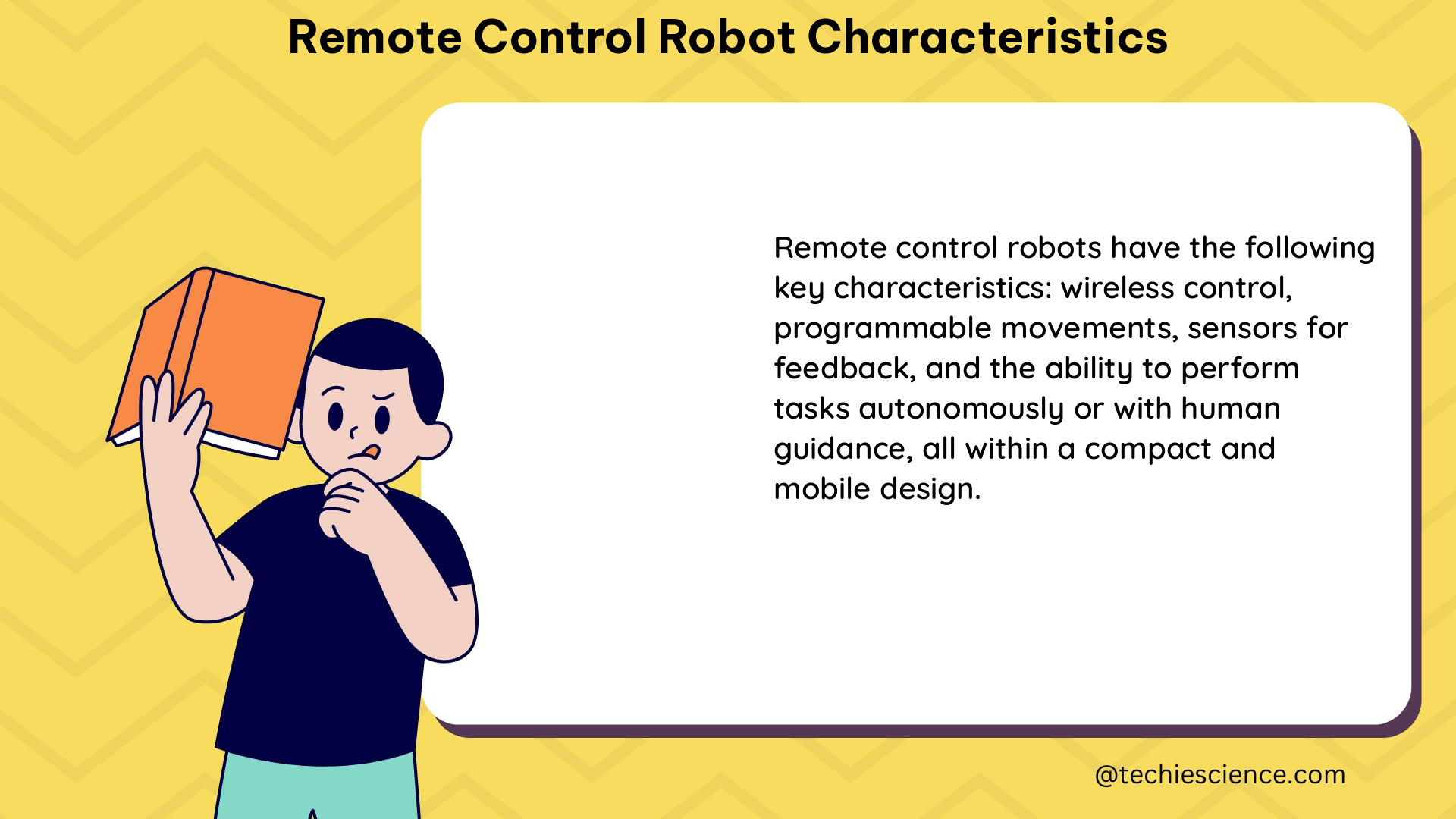Remote control robots are versatile electronic devices that can be operated remotely to perform a wide range of tasks. Understanding the key characteristics of these robots is crucial for their effective deployment and optimization. This comprehensive guide delves into the technical details and quantifiable aspects of remote control robot characteristics, providing a valuable resource for science students and enthusiasts.
Control Accuracy
Control accuracy is a critical parameter that determines the precision with which a remote control robot can execute commands and achieve the desired position or movement. This characteristic can be quantified using the following metrics:
- Position Accuracy: Measured as the deviation between the target position and the actual position of the robot, typically expressed in linear (e.g., millimeters) or angular (e.g., degrees) units.
- Trajectory Accuracy: Evaluated by comparing the planned trajectory with the actual trajectory followed by the robot, often expressed as the root-mean-square error (RMSE) or maximum deviation.
- Repeatability: Quantified by repeatedly executing the same task and measuring the variability in the robot’s performance, indicating its ability to consistently achieve the desired outcome.
The control accuracy of a remote control robot is influenced by factors such as the precision of the control system, sensor resolution, and the mechanical design of the robot’s components.
Response Time

Response time is a crucial characteristic that determines the robot’s ability to react to user commands in a timely manner. It can be measured as the time delay between the issuance of a command and the robot’s corresponding action. Factors that affect response time include:
- Communication Latency: The time it takes for the command signal to travel from the controller to the robot, which can be influenced by the communication protocol, network bandwidth, and distance.
- Processing Time: The time required for the robot’s onboard microcontroller or processor to interpret the command and generate the appropriate response.
- Mechanical Constraints: The time it takes for the robot’s actuators (e.g., motors, servos) to physically execute the commanded movement or action.
Reducing response time is essential for applications that require real-time control, such as teleoperation or high-speed maneuvering.
Precision
Precision is a measure of the consistency and repeatability of a remote control robot’s movements or actions. It can be quantified by repeatedly executing the same task or movement and measuring the variability in the robot’s performance. Factors that contribute to precision include:
- Sensor Accuracy: The resolution and accuracy of the robot’s sensors, such as encoders, gyroscopes, and accelerometers, which provide feedback for closed-loop control.
- Mechanical Tolerances: The manufacturing quality and assembly precision of the robot’s mechanical components, which can affect the consistency of its movements.
- Control Algorithm: The sophistication and tuning of the control algorithms used to translate user commands into precise robot actions.
A high degree of precision is essential for applications that require consistent and reliable performance, such as assembly, inspection, or surgical procedures.
Payload Capacity
The payload capacity of a remote control robot refers to the maximum weight or force that the robot can handle without compromising its performance or stability. This characteristic can be measured in terms of:
- Maximum Payload Weight: The maximum weight the robot can lift or carry without exceeding its structural or actuator limitations.
- Maximum Payload Force: The maximum force the robot can exert or withstand, such as during pushing, pulling, or grasping tasks.
The payload capacity is influenced by factors such as the robot’s size, weight, motor torque, and structural design. Knowing the payload capacity is crucial for selecting the appropriate robot for a given application, ensuring safe and reliable operation.
Maneuverability
Maneuverability is a measure of a remote control robot’s ability to navigate and move within a confined or complex environment. It can be quantified by evaluating the following parameters:
- Turning Radius: The minimum radius the robot can turn while maintaining stability and control.
- Maximum Speed: The highest velocity the robot can achieve in a straight line or during maneuvering.
- Acceleration and Deceleration: The rate at which the robot can change its speed, both in the positive and negative directions.
Factors that influence maneuverability include the robot’s size, weight distribution, wheel or track configuration, and the control algorithms used for navigation and motion planning.
Communication Range
The communication range is a critical characteristic that determines the maximum distance between the controller and the remote control robot within which reliable communication can be maintained. This range can be measured in terms of:
- Line-of-Sight Distance: The maximum distance the robot can be operated within a direct, unobstructed line of sight between the controller and the robot.
- Obstacle-Penetrating Range: The maximum distance the robot can be operated while accounting for obstacles, walls, or other interference between the controller and the robot.
The communication range is influenced by factors such as the communication protocol (e.g., Wi-Fi, Bluetooth, RF), transmitter power, antenna design, and environmental conditions.
Battery Life
The battery life of a remote control robot is an essential characteristic that determines the duration of its operation before requiring recharging or replacement. It can be measured in terms of:
- Operating Time: The length of time the robot can operate on a single charge, typically expressed in hours or minutes.
- Charge/Discharge Cycles: The number of times the robot’s battery can be recharged before its capacity significantly degrades.
The battery life is influenced by factors such as the battery technology (e.g., lithium-ion, NiMH), battery capacity, power consumption of the robot’s components, and power management strategies.
Durability
Durability is a measure of a remote control robot’s ability to withstand wear, tear, and environmental factors such as temperature, humidity, and dust. It can be quantified by subjecting the robot to various stress tests and measuring its performance degradation over time. Aspects of durability include:
- Mechanical Robustness: The robot’s resistance to physical impacts, vibrations, and other mechanical stresses.
- Environmental Resistance: The robot’s ability to operate reliably in different environmental conditions, such as temperature extremes, moisture, or dust.
- Maintenance Requirements: The frequency and complexity of maintenance tasks required to keep the robot in optimal working condition.
Durable remote control robots are essential for applications in harsh or demanding environments, where the robot’s reliability and longevity are critical.
Technical Specifications and DIY Aspects
In addition to the measurable and quantifiable characteristics, remote control robots can also be evaluated based on their technical specifications and DIY aspects, which include:
- Control System: The hardware and software components that enable remote operation, including the controller, communication interface, sensors, actuators, and processing units.
- Power Source: The type of power source used, such as batteries, fuel cells, or other portable energy storage devices, and its compatibility with the robot’s size, weight, and power requirements.
- Sensors and Actuators: The types of sensors (e.g., cameras, infrared, ultrasonic, laser rangefinders) and actuators (e.g., motors, servos, hydraulic systems) used to perceive the environment and interact with it.
- Communication Protocol: The communication protocol (e.g., Wi-Fi, Bluetooth, Zigbee, RF) used for reliable and efficient data transfer between the controller and the robot.
- Software: The firmware running on the robot’s microcontroller or processor, as well as the application software on the controller, which can significantly impact the robot’s functionality, usability, and customizability.
- DIY Aspects: The ease of assembly, modification, and customization of the remote control robot, often indicated by the availability of detailed instructions, schematics, and open-source software.
Understanding these technical specifications and DIY aspects is crucial for selecting the appropriate remote control robot for a specific application and for enabling enthusiasts to customize and enhance the robot’s capabilities.
By comprehending the various measurable and quantifiable characteristics, as well as the technical specifications and DIY aspects of remote control robots, science students and enthusiasts can make informed decisions, optimize the performance of these robots, and explore the vast potential of this technology.
References:
– Bioinspired Implementation and Assessment of a Remote-Controlled Robot
– Standard Test Methods For Response Robots
– Human Factors Considerations for Quantifiable Human States in Human-Robot Interaction
– Remote Control of Mobile Robot using the Virtual Reality Robot
– Robot tool use: A survey

I have a background in Aerospace Engineering, currently working towards the application of Robotics in the Defense and the Space Science Industry. I am a continuous learner and my passion for creative arts keeps me inclined towards designing novel engineering concepts.
With robots substituting almost all human actions in the future, I like to bring to my readers the foundational aspects of the subject in an easy yet informative manner. I also like to keep updated with the advancements in the aerospace industry simultaneously.